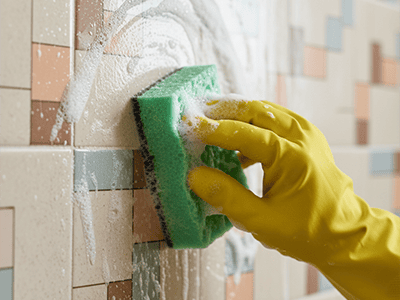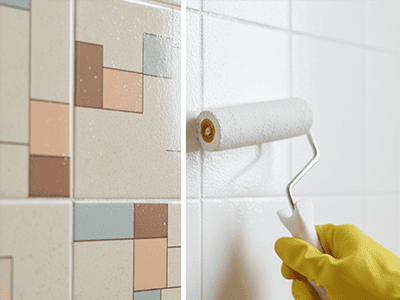Can You Paint Tiles?
A Guide to Painting Bathroom and Laundry Tiles
Is your bathroom or laundry stuck in a time warp with dated, patterned, or just plain ugly tiles? A full retiling job is a massive, expensive, and disruptive undertaking. This leads many Aussie homeowners to ask the question: "Can I just paint over them?" The answer is yes, you absolutely can – but with a very big catch. You cannot simply slap a coat of wall paint on them and expect it to last. Tiles are a non-porous, ultra-smooth, high-gloss surface designed to repel everything. To paint them successfully, you must use a specific system of specialised products and follow a meticulous preparation process. Get it right, and you can achieve a stunning, modern transformation for a fraction of the cost of retiling.
This is a System, Not Just a Paint Job
Painting tiles is all about creating a super-strong bond between a new coating and a surface that doesn't want to be coated. This requires a three-part system: an extreme clean, a high-adhesion primer, and a tough, durable topcoat.

Step 1: The Ultimate Decontamination Clean
This is the most important step. Years of soap scum, body oils, and cleaning product residue create a film on tiles that will block any primer from sticking. A quick wipe-down is not enough.
- Scrub the Grout: Start by giving all the grout lines a deep scrub with a grout cleaner and a stiff brush to remove any mould or grime.
- A Heavy-Duty Clean: You need to use a powerful abrasive cleaner. A product like Gumption, or even just a paste of bicarb soda, applied with a scourer pad is perfect. Scrub every single tile and grout line with serious effort to remove all traces of soap scum and residue.
- Rinse and Dry: Rinse the walls thoroughly with clean water to remove all the cleaning product, then dry them completely with old towels. Let the room air out for several hours to ensure the grout lines are bone dry.
Step 2: The All-Important Adhesion Primer
This is the product that makes the entire job possible. Standard wall primer will not work. It will peel off.

- Choose a Speciality Primer: You must use a primer specifically designed for difficult, glossy surfaces. Go to your local paint shop and ask for a "specialist primer for tiles and laminate." In Australia, products like Dulux Precision Maximum Strength Adhesion Primer or Zinsser Bullseye 1-2-3 are the go-to choices for this job.
- Apply a Thin, Even Coat: A small foam roller is the best tool for this. It will leave a smooth, spray-like finish on the tiles. Use a small brush for the grout lines and corners, then immediately roll the tiles while the grout lines are still wet. Apply one thin, even coat and let it dry completely as per the can's instructions.
Step 3: The Protective Topcoat
Once the primer is on, you need to protect it with a tough topcoat. Again, wall paint is not suitable. You need a product that cures to a hard, water-resistant finish.
- Use a Tile Paint or Water-Based Enamel: Many brands now offer a specific "Tile Paint" which is the easiest all-in-one topcoat. Alternatively, a high-quality water-based enamel like Dulux Aquanamel in a semi-gloss finish is an excellent, hard-wearing option.
- Apply Two Thin Coats: Using a fresh foam roller, apply two thin topcoats. Allow the first coat to dry completely before applying the second.
- Curing Time is Crucial: This is vital for durability in a wet area. The paint may feel dry in a few hours, but it needs to fully cure and harden. You must avoid using the shower or getting the tiles wet for at least 3-5 days (check the product instructions) to allow the paint to reach its maximum hardness.
Pro Tip from a Sydney Painter
While painting wall tiles is a great DIY solution, we generally do not recommend painting floor tiles in high-traffic areas like bathrooms, as the coating will eventually wear through. It's also important to be realistic – a painted tile finish is a fantastic cosmetic upgrade, but it will never be as durable as the original baked-on glaze of the tile itself. At DRJ Painting, when we undertake a tile painting project, we use specialised, two-part epoxy products and professional application techniques to achieve the hardest and most durable finish possible.

